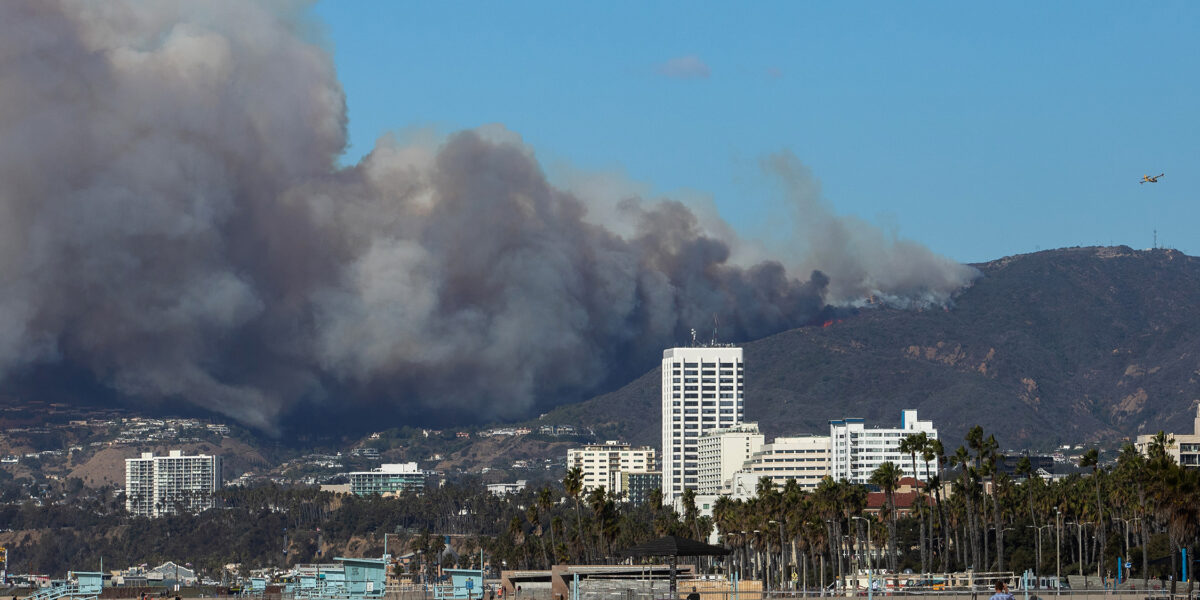
As Wildfires Rage, a 100-Year-Old Copy of Sunset Magazine Offers a Message of Resilience
When natural disaster strikes, Sunset’s editor-in-chief turns to an old issue of the magazine for the long view on the Western tradition of resilience and recovery.

I write this from the relative safety of my home in the flats of Los Angeles miles away from where the fires that, as of this writing, have destroyed over 1,000 homes and businesses, displaced over 100,000 people. The sky glows an eerie orange gray and smoke taints the air, the sum total of the destruction and the impending grief over loss are as of now incalculable.
Every year as the Santa Anas blow we hope for the best, but this time the worst has come to pass. When you’re on a frontier, which the West will always be, you are by definition pushed up against the wild. And the wild has its own rules, despite our efforts to tame it. The ratios of pleasure to pain are mercifully so often in our favor, but for all of the moments of sudden beauty, say of a wildflower superbloom, there’s a counterpoint: the inevitable dry season when brush can turn to fuel and the fires come. The same swells that thrill surfers can take down our historic piers. It’s a contrast of pushes and pulls, and gives and takes, made all the more dramatic by the stark contrast of the extreme beauty we’re lucky to live in.
And when disasters befall us, time and again the inevitable response is one of an immediate outpouring of selflessness and resilience. And I’ve already witnessed resilience among the flow of videos of destruction: the ongoing heroic efforts of the first responders, the stories of friends and strangers taking the displaced into their homes, neighbors defending neighbors homes, the relief organizations, non-profits, places of worship, animal shelters, and more that, as they always do, immediately step up to assist the community. The distraction tool of social media is transformed into a utility for the sharing of information about how to help, get help, and stay safe.

Sunset
In times like this I return to an old edition of Sunset published immediately following the devastating 1906 San Francisco earthquake. An illustration by the great Western artist Maynard Dixon entitled “Spirit of the City” featuring a woman boldly rising above the city on fire graces its cover. Despite the fact that their offices were destroyed, much of the city leveled, and one-sixth of it further destroyed by fire, the editors took it upon themselves to publish an albeit slim eight-page pamphlet. It included a letter from the staff that, despite the extreme destruction, carried a deeply felt message that was hopeful and captured the spirit of the West that still rings true as it did some 100 years ago. Here we publish a letter from the editors to their readers that still rings true today as it did some 100 years ago:
“In this one day the accumulation and accomplishment of years were swept away. The fire spread over only about one-sixth of San Francisco’s total area, but destroyed all the central business portion of the city and a large residence district. Business blocks, factories, palatial homes, modern hotels, apartment, and lodging houses disappeared. In this one day all class distinctions were leveled. And then here the great Lesson of Love was taught, and the best that is in Humankind rose above all pride of place and possessions. That was the flower that blossomed amid the city’s ruins, and for it Glory be. The men and the women and the children forget all personal loss, forgot their own sorrow in giving joy and comfort, coffee and buns and blankets, smiles and sturdy words of brave sympathy and of glad promise. The spirit unconquerable and I-won’t-be-crushed rose quickly above all fearsome dread, with a blithe Good-bye to the Old and echoing cheers for the New. The sun shone through the lurid clouds of cinders and the City-That-is-to-Be was planned even as the flames ran from hill to hill over the City-That-Was. Hope springs eternal, the outlook is bright, and aims are high. Committees have been organized and steps taken that are sure to lead to successful achievement. The spirit of men that was alive in California’s early days has asserted itself and is bound to force rapid recovery and development. This magazine has won for itself a name and fame which no loss can force it to abandon. San Francisco will be rebuilt, and be made a City Beautiful on lines already adopted, and Sunset will rise to help to tell all the world, as it has in the past, of the progress and advancement of all the Far West, from the Mississippi River to California and the Islands of the Sea, from the tablelands of Mexico to the gold tundra fields of Alaska. In this vast section are resources unparalleled and opportunities unequaled. The West is calling today, as it has in the past, for men of brains and grit to aid its development. In certain sections its climate lures the sick and the world weary; its charm of mountains, canyons, sea and forest attracts the painters and poets, and all skilled in arts creative. To tell of the work of such, to picture the West, to cheer and help the general upbuilding in all things that make for the best civilization—that has been the mission of Sunset and will so continue.”
